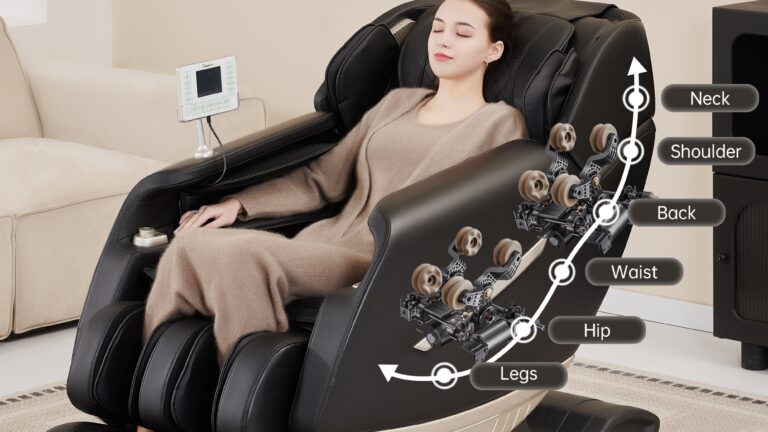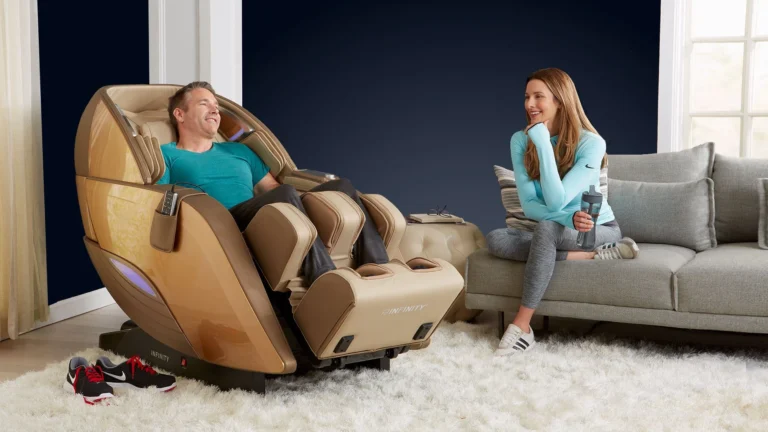A noisy home massage chair can be pretty annoying, especially when you’re trying to relax and enjoy a soothing massage. Whether it’s a constant hum, a loud whirring sound, or a more mechanical clanking noise, there are a few things you can check to figure out what’s going on and how to fix it. Let’s go over some common causes and solutions to help quiet down your chair.
1. Check the Positioning
Sometimes, the noise can be as simple as the positioning of your massage chair. If the chair isn’t on a flat, stable surface, it may cause unnecessary vibrations and noises. To fix this:
- Make sure the chair is on a level surface. Even a slight tilt or uneven floor can cause parts to rub together or vibrate in ways that create more noise.
- Check for anything obstructing the wheels or base. If there’s anything like a rug or debris that’s interfering with the chair’s movement, it could lead to noise. Clear the area around the chair and make sure it’s sitting flat.
2. Lubricate Moving Parts
Most massage chairs have parts that move and adjust during use, such as rollers, airbags, or recliners. Over time, these parts can become stiff or dry, which can cause friction and lead to noisy operation. The good news is that a little lubrication can go a long way:
- Apply lubricant to moving parts. For example, spray a small amount of silicone lubricant on the rollers, joints, and any other moving parts. Avoid using oils that can attract dirt or grime.
- Check the manual for recommended lubricants. Some chairs may have specific guidelines for what kind of lubricant to use, so it’s worth checking the user manual before you apply anything.
3. Inspect for Loose Parts or Screws
A loud noise could be the result of loose parts or screws. Over time, parts can get a bit wobbly or come undone, especially if the chair gets a lot of use. To fix this:
- Tighten any loose screws or bolts. Use a screwdriver to check all visible screws around the chair. Tightening them can help reduce rattling or vibrating noises.
- Check the frame and body for loose components. If any part of the frame feels loose or unstable, try tightening it or contacting the manufacturer if it seems like it might be defective.
4. Check the Rollers and Mechanism
The rollers inside the chair play a key role in giving you a deep massage, but if they’re malfunctioning or blocked, they could make loud noises. Here’s what to do:
- Inspect the rollers. If you notice any debris or foreign objects stuck near the rollers, clean them out gently.
- Test the mechanism. If the rollers are grinding or making harsh noises while moving, the mechanism may need some adjustments. This might require professional help, so consider reaching out to customer service if cleaning doesn’t solve the problem.
5. Examine the Airbags and Blower
Some massage chairs use airbags to provide compression and other therapeutic features. If these airbags aren’t properly inflated or are malfunctioning, they can make strange sounds during operation. Here’s what you can do:
- Check the air pressure. If the airbags seem deflated or overinflated, this could cause excess noise. Ensure that the air pressure is at the correct level according to your chair’s manual.
- Listen for air leakage. If you hear a hissing noise, there could be an air leak in the system. In this case, you may need to contact customer support for repairs or replacements.
6. Clean the Chair Regularly
Dust and dirt can build up inside your massage chair, especially around the moving parts. If the chair hasn’t been cleaned in a while, this buildup can cause friction, which can lead to noise. To fix this:
- Vacuum the chair. Use a vacuum cleaner with a hose attachment to clean the chair’s seams, rollers, and other components.
- Wipe down the surface. Use a damp cloth to remove any dirt or dust from the chair’s outer surfaces.
- Clean the motor vents. Sometimes, dust can accumulate in the vents, causing the motor to overheat and create extra noise. Make sure the vents are clear.
7. Contact Customer Support
If you’ve tried everything—checking the positioning, lubricating the parts, tightening screws, and cleaning—and the noise persists, it might be time to reach out to the manufacturer’s customer service team. There could be an internal issue, like a faulty motor or malfunctioning component, that requires professional attention.
- Check the warranty. If your chair is still under warranty, the manufacturer might repair or replace any defective parts.
- Request an inspection. If the chair is out of warranty, customer support might still offer advice or a recommended repair service.
Final Thoughts
A noisy massage chair can be frustrating, but with a little troubleshooting, you can likely figure out the cause and get it running quietly again. By checking the positioning, lubricating parts, tightening screws, and keeping it clean, you’ll be well on your way to enjoying a peaceful, relaxing massage once more. If the noise continues, don’t hesitate to reach out to the manufacturer for further assistance.



